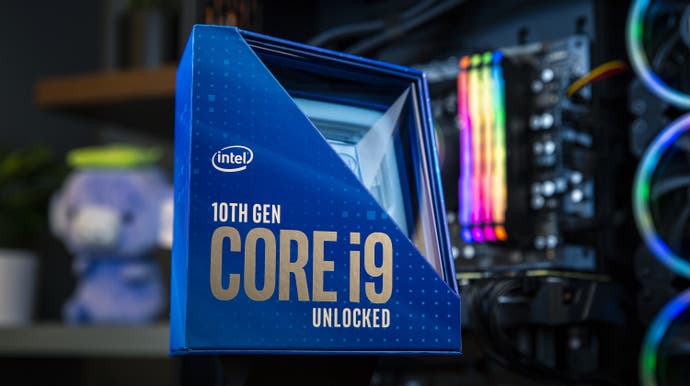Intel announces specs and features of 10th-gen Comet Lake desktop CPUs
From the cheap Core i3-10100 to the flagship Core i9-10900K.
Intel officially announced its 10th-generation Core desktop processors today, from the $122 Core i3 10100 all the way up to the $488 Core i9 10900K. Like its Comet Lake H mobile processors, announced in early April, the big focus here is on single-core performance through frequency gains - with several models pushing past 5GHz and the flagship model hitting 5.3GHz - but there are also higher core and thread counts for many models. Intel also detailed some nice feature additions for enthusiasts and overclockers which look promising - but will it be enough to reverse the trend towards AMD Ryzen for gamers and content creators? Here's what you need to know about Comet Lake on desktop.
First, let's take a look at the full Comet Lake Core lineup. We're seeing faster frequencies more or less across the board compared to the Coffee Lake refresh of 2019, but there are also some interesting design changes to note.
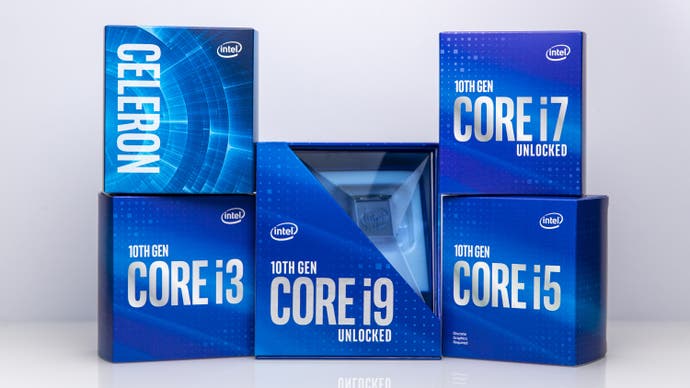
Core i9 processors now have ten hyper-threaded cores, up from eight last gen, while Core i3, Core i5 and Core i7 keep their ninth-gen core counts (four, six and eight, respectively) but gain hyper-threading. Finally, the tray prices here are exactly the same as last-gen, which hopefully will translate into similar prices at retail despite the current human malware situation.
| Processor | Cores/Threads | Base Clock | Single/All Core Turbo | TDP | Cost |
|---|---|---|---|---|---|
| Core i9-10900K* | 10/20 | 3.7GHz | 5.3GHz/4.9GHz | 125W | $488 |
| Core i9-10900*† | 10/20 | 2.8GHz | 5.2GHz/4.6GHz | 65W | $439 |
| Core i7-10700K* | 8/16 | 3.8GHz | 5.1GHz/4.7GHz | 125W | $374 |
| Core i7-10700*† | 8/16 | 2.9GHz | 4.8GHz/4.6GHz | 65W | $323 |
| Core i5-10600K* | 6/12 | 4.1GHz | 4.8GHz/4.5GHz | 125W | $262 |
| Core i5-10600† | 6/12 | 3.3GHz | 4.8GHz/4.4GHz | 65W | $213 |
| Core i5-10500† | 6/12 | 3.1GHz | 4.5GHz/4.2GHz | 65W | $192 |
| Core i5-10400*† | 6/12 | 2.9GHz | 4.3GHz/4.0GHz | 65W | $182 |
| Core i3-10320 | 4/8 | 3.8GHz | 4.6GHz/4.4GHz | 65W | $154 |
| Core i3-10300† | 4/8 | 3.7GHz | 4.4GHz/4.2GHz | 65W | $143 |
| Core i3-10100† | 4/8 | 3.6GHz | 4.3GHz/4.1GHz | 65W | $122 |
To keep this chart to a manageable size, note that there are asterisks(*) to denote processors which have a corresponding 'F' version, which comes without integrated graphics but costs slightly less - eg the 10900KF. We have also used daggers (†) to indicate processors with corresponding 'T' versions, which operate at a highly reduced 35W TDP and lower clockspeeds, intended for use in all-in-one or other small form factor desktops - e.g. the 10900T. As usual, the 'K' suffix denotes an unlocked (and therefore overclockable) processor.
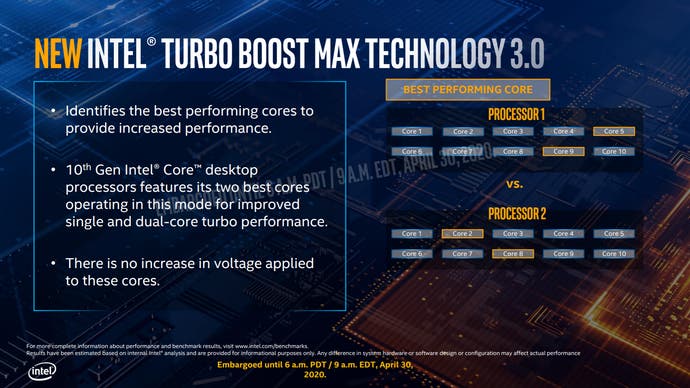
There are several technologies contributing to maximum turbo values here. Core i7 and i9 models are equipped with "Turbo Boost Max Technology 3.0", which identifies the two fastest cores in your particular processor, runs them at higher frequencies (but not higher voltages) and prioritises them in lightly-threaded workloads. This tool arrived on Core X-series chips last autumn, but this is the first time it's been on consumer-grade processors. Meanwhile, Core i9 models also get "Thermal Velocity Boost" or TVB, which opportunistically increases processor frequency if thermal and power constraints allow. That suggests you may need a beefy cooling solution, such as a dual-fan air cooler or a 240mm or larger AIO, to consistently hit the quoted single-core and all-core frequencies on the Core i9 models.
While increases to core count, thread count and frequency should result in a higher thermal load, Intel has also made some changes to its soldered thermal interface material (STIM) which could push things in the other direction. The company is now producing thinner silicon dies, while using thicker integrated heat spreaders (IHS) with a higher copper content to ensure the entire package remains the same size. The differences we're talking about here are a matter of microns, but trading even a small amount of thermally resistive silicon for thermally conductive copper should result in better heat transfer and therefore an increase in sustained performance.

So the big question is this: will all these changes make a big difference to performance? Intel's press materials suggest frame-rate improvements between 10 per cent (the ever-popular PUBG) and 33 per cent (the early access title Mount and Blade 2: Bannerlord) going from the Core i9-9900K to the Core i9-10900K. We might see even bigger performance gains in the Core i3, Core i5 and Core i7 chips which also get the advantage of hyper-threading. Of course, it won't be until we can test these chips ourselves that we can know for sure.
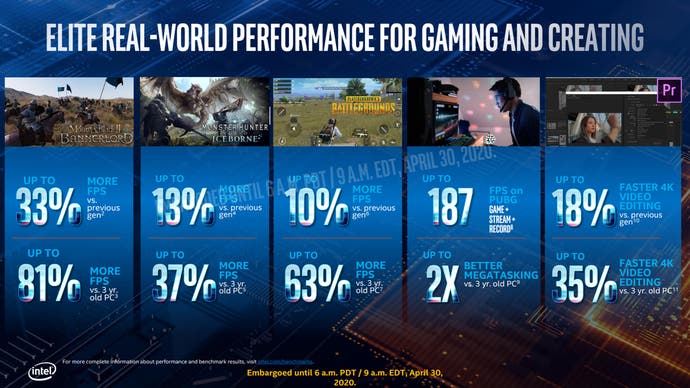
As well as increasing out-of-the-box performance, Intel has spent a lot of time working on overclocking for their next-gen chips. There are a number of new and expanded features arriving with Comet Lake, but the standout addition here is the ability to enable or disable hyper-threading (HT) on a per-core basis. HT is useful because it allows processors to run heavily-threaded applications faster, but having HT enabled often reduces performance in lightly-threaded tasks and increases heat generation. Therefore, if you know a particular game or application only makes use of a certain number of threads, you can tune your system to offer exactly that number. For example, if you had a game that used up to six threads, and you were on a four-core, eight-thread processor, you could disable hyper-threading on two cores to maximise your performance. With a greater number of cores and threads available in modern CPUs, being able to adapt thread count to a given task could result in some solid performance improvements.

There are other new tweaking possibilities in Intel's overhauled Extreme Tuning Utility app. For example, PEG/DMI overclocking is available, which could be used to overclock a chip's integrated graphics, and there are more fine-grained controls for the voltage/frequency curve, unlocking the ability to better tune your system for power usage or performance. As well as new features, the app also looks better and provides real-time telemetry logging, which again will be useful for overclocking enthusiasts.
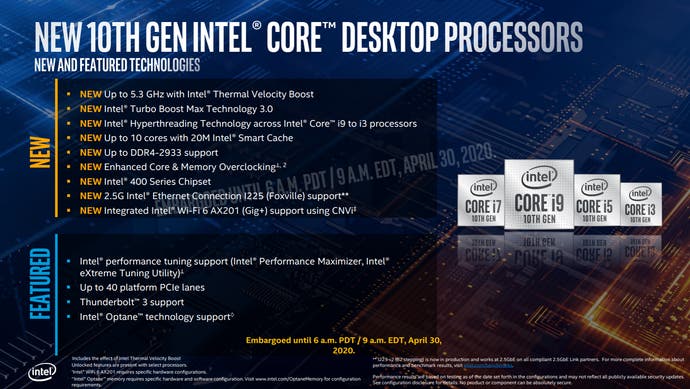
New Intel processors often require new chipsets, and that's the case again here. The new CPUs will require a new socket, LGA1200, and there will be several Intel 400-series chipsets - with the first available platform to be the high-end Z490, followed by the successively cheaper H470, B460 and H410.
The 400-series chipsets support up to DDR4-2933MHz memory as standard (with many boards exceeding this), and many will also feature a 2.5-gigabit I225 ethernet controller and integrated Wi-Fi 6 Gig+. Note that PCIe 4.0 support isn't mentioned at all, so presumably this feature will remain exclusive to AMD's recent platforms for the immediate future. Final pricing hasn't yet been announced, but expect the first Z490 boards - like the Asus Maximus 12 Extreme shown below - to be premium propositions.
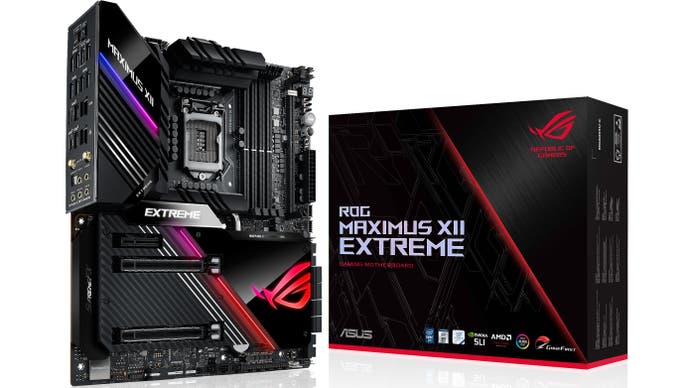
So there we have it - a whole new generation of Intel processors, again produced using that familiar 14nm++ process but offering higher core counts, higher thread counts and faster frequencies - not to mention a nice spread of automatic turbo boosting and manual overclocking features and a whole new chipset family.
It's clear to see the effect that the runaway success of AMD's Ryzen processors has had, and it'll be fascinating to see whether Intel will be able to make up any ground against Team Red in content creation workloads and hold onto its advantage in gaming. We look forward to testing these processors ourselves to let you know exactly how they perform.
